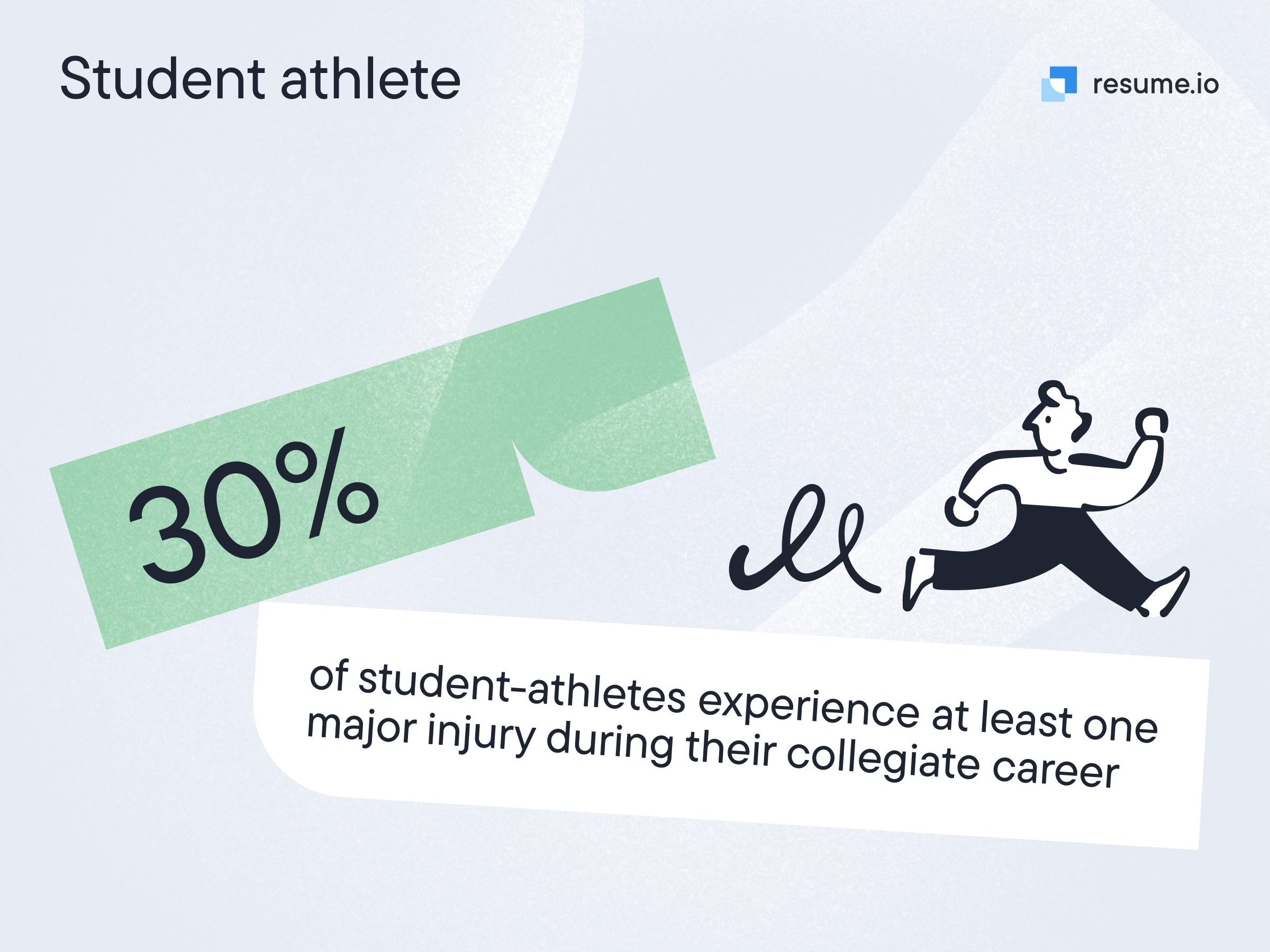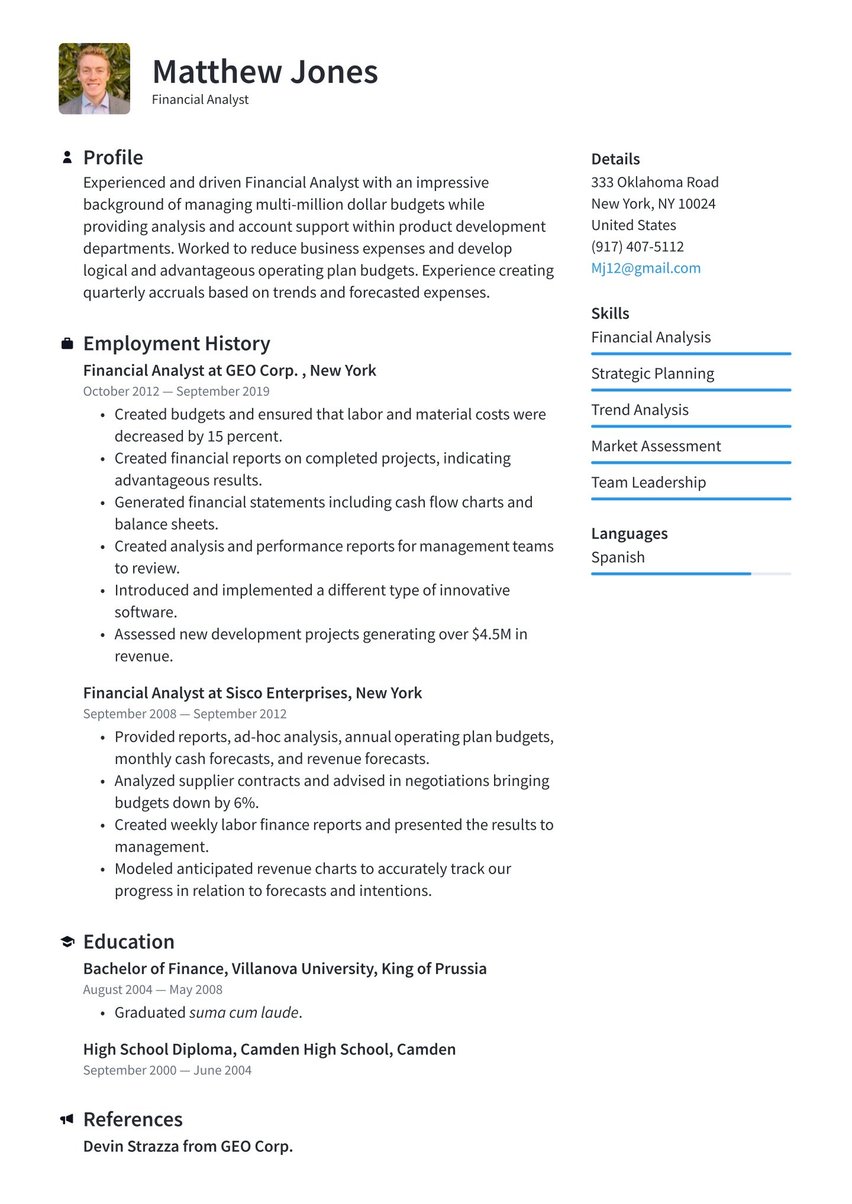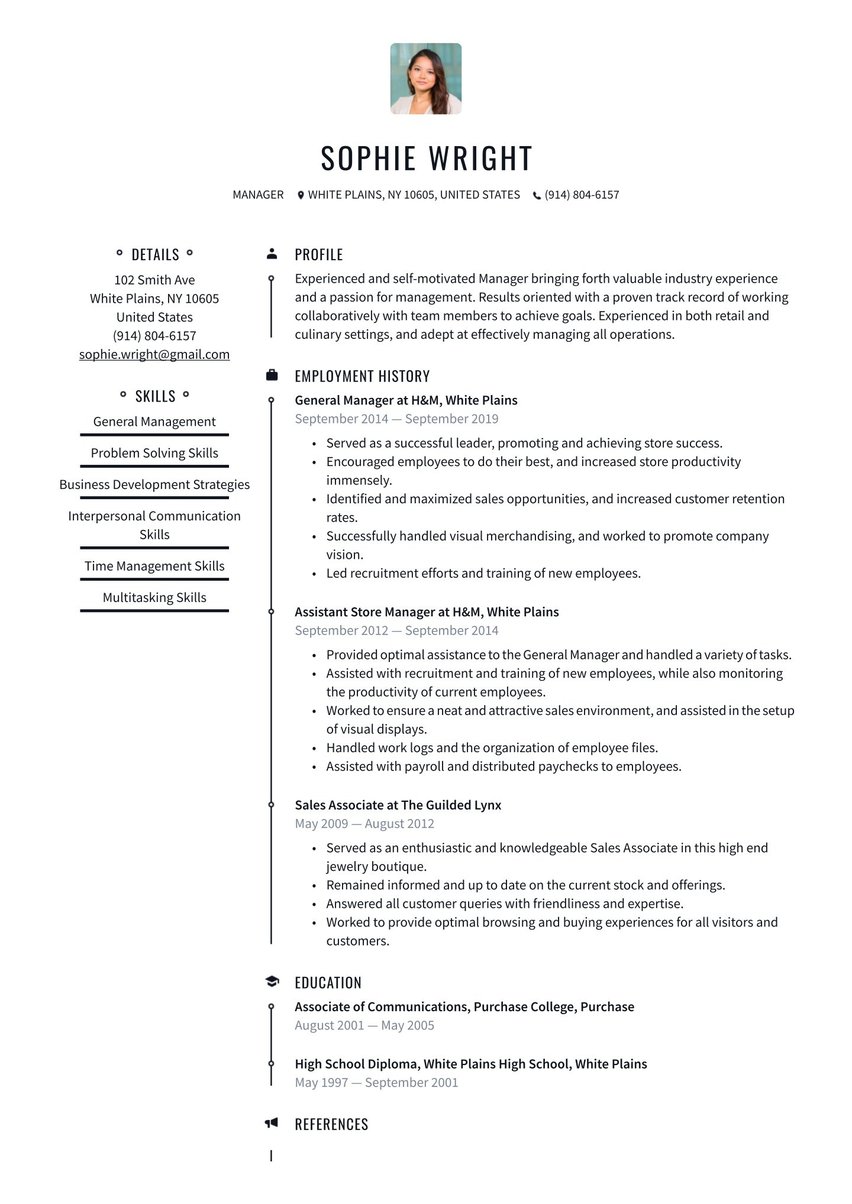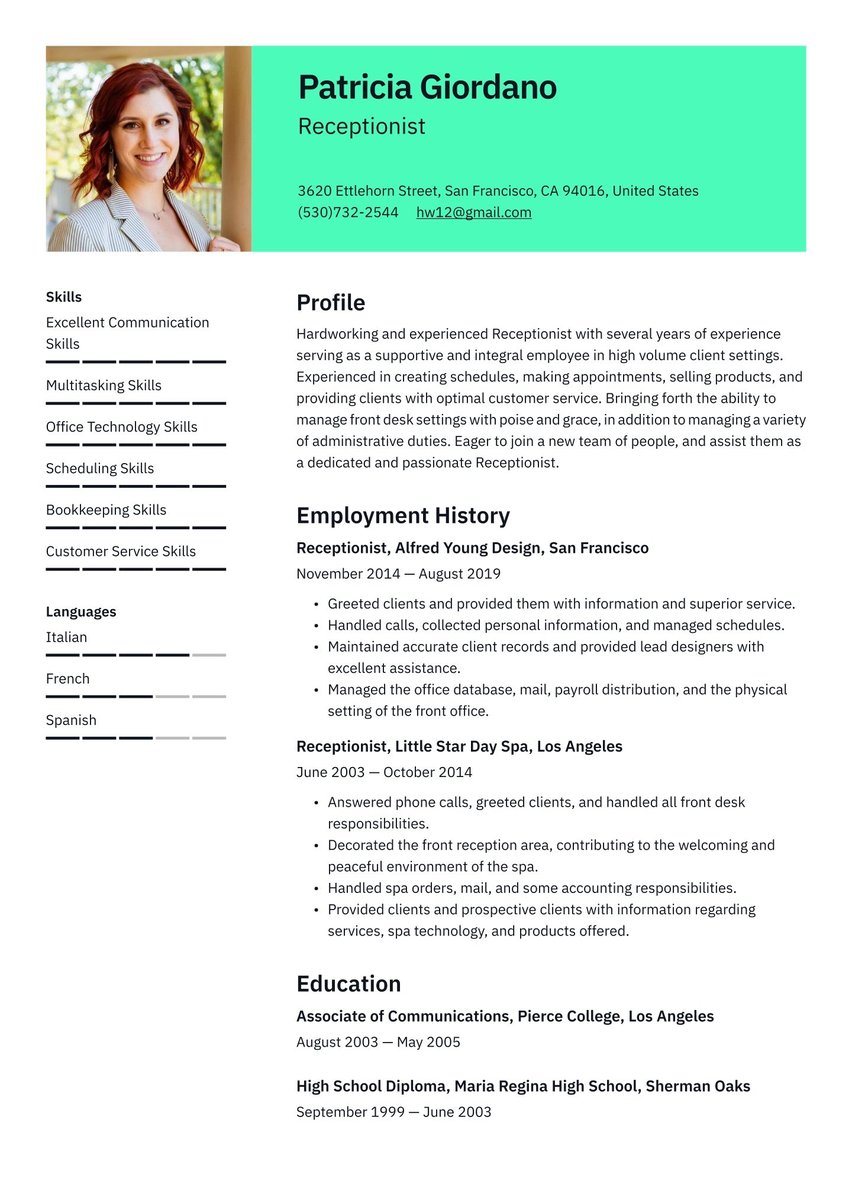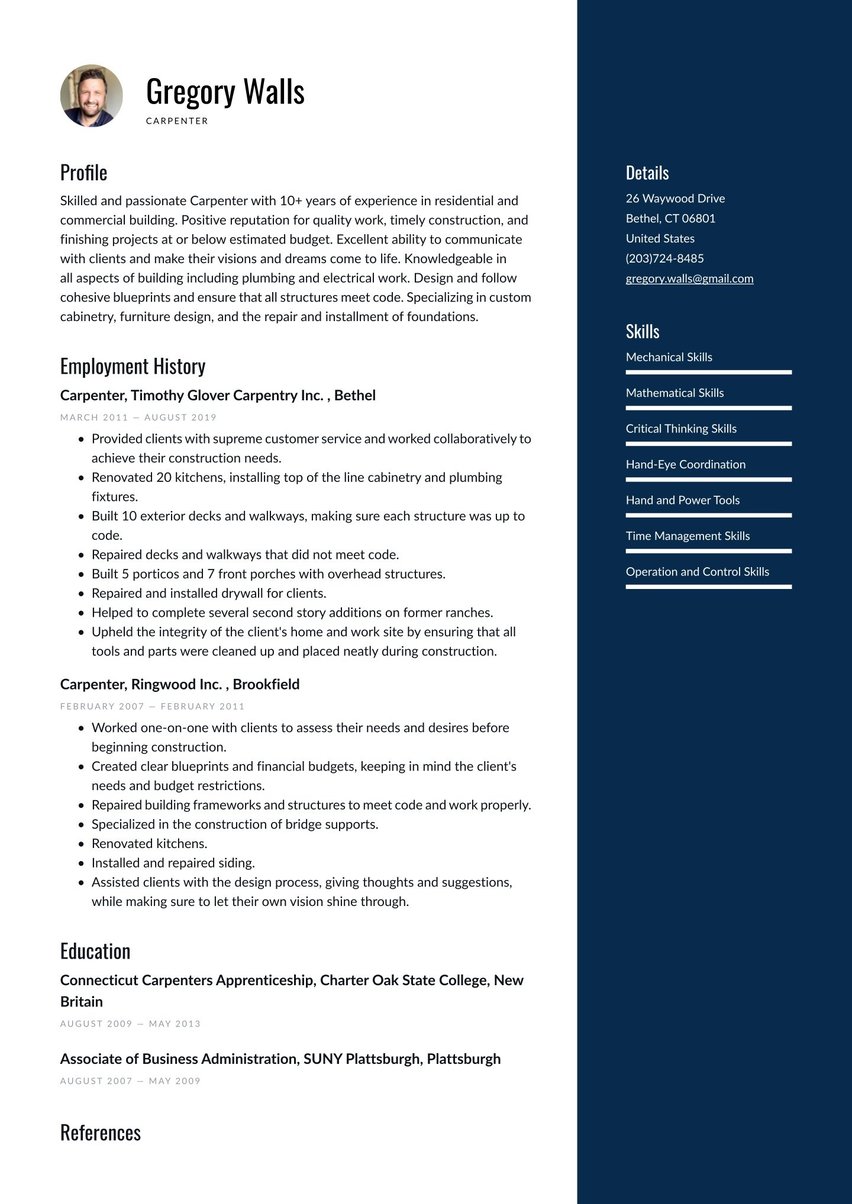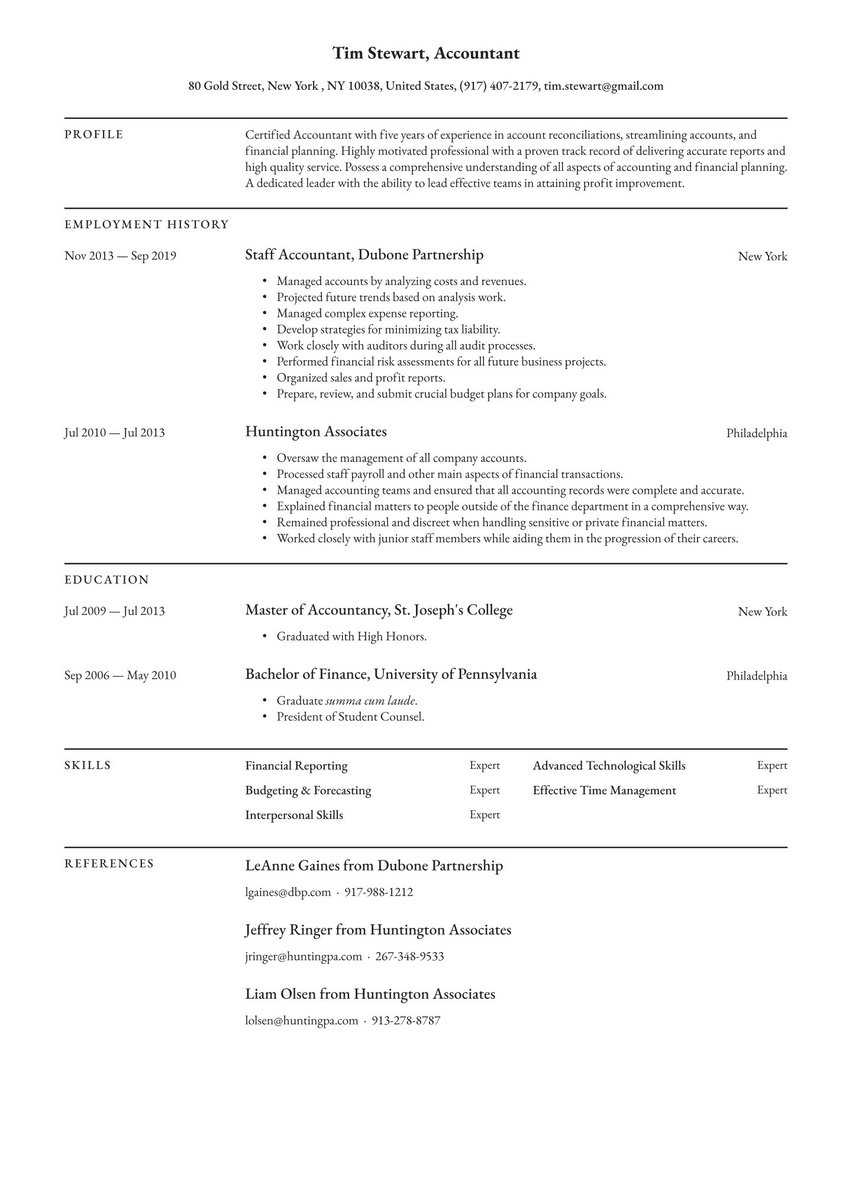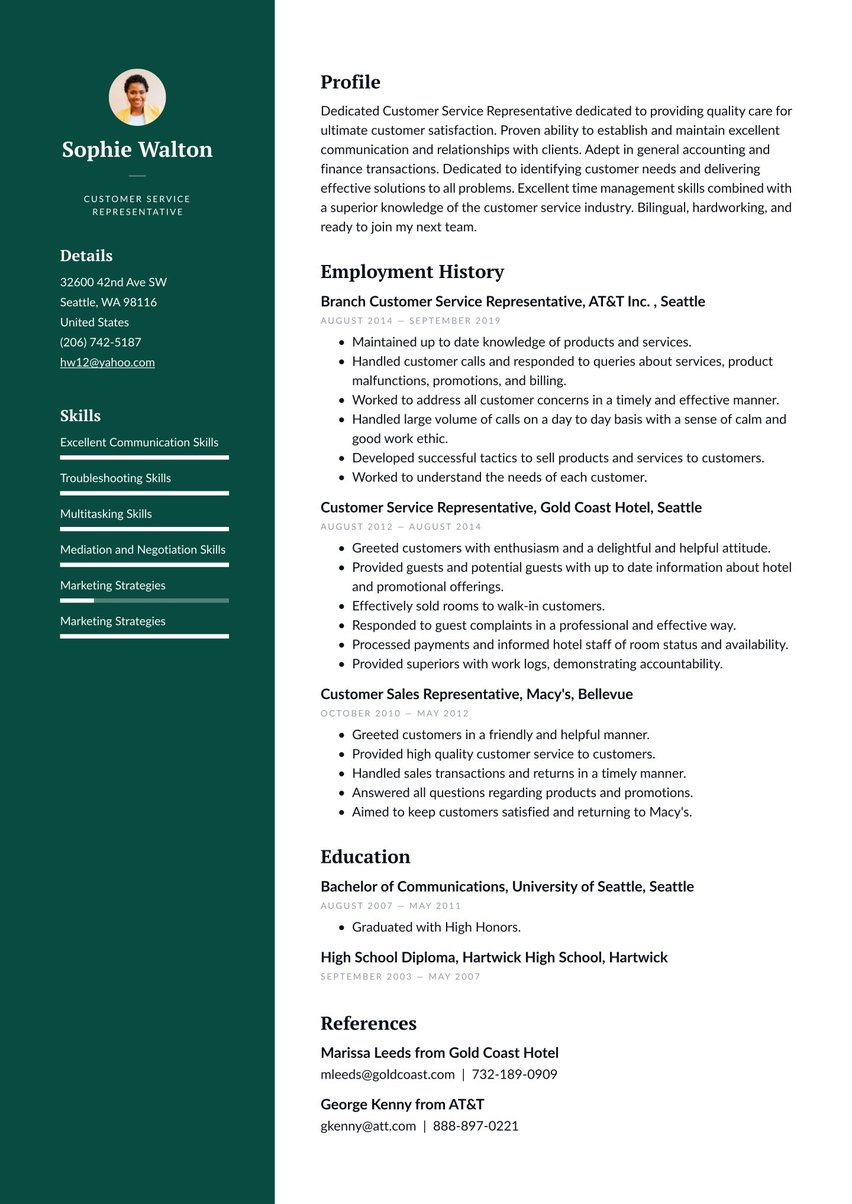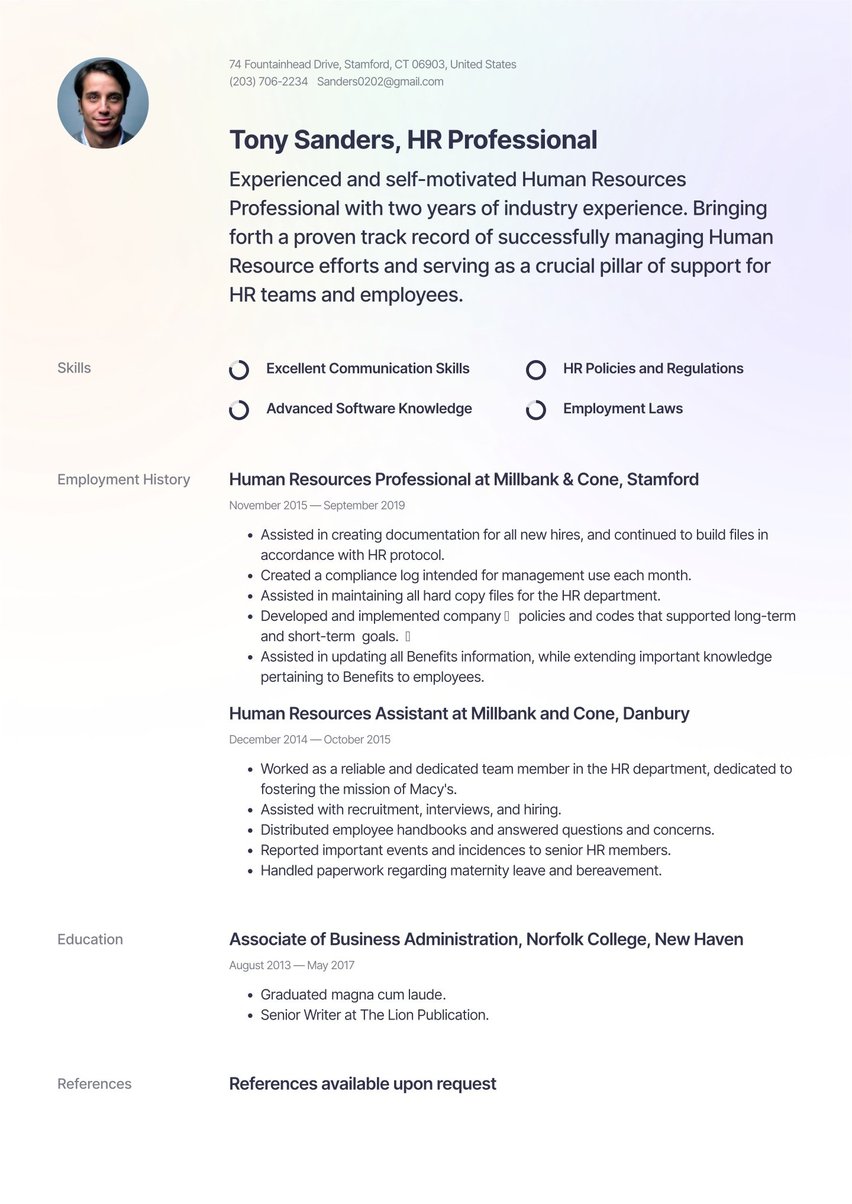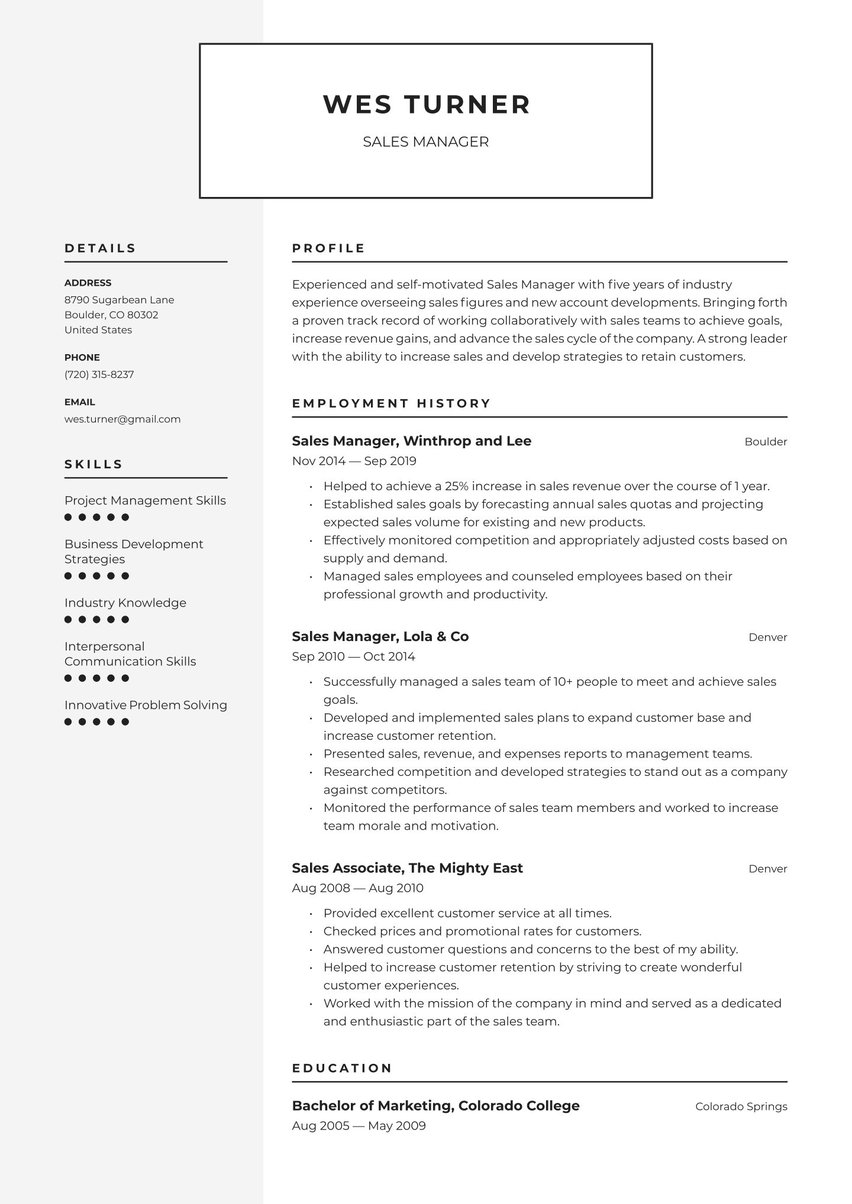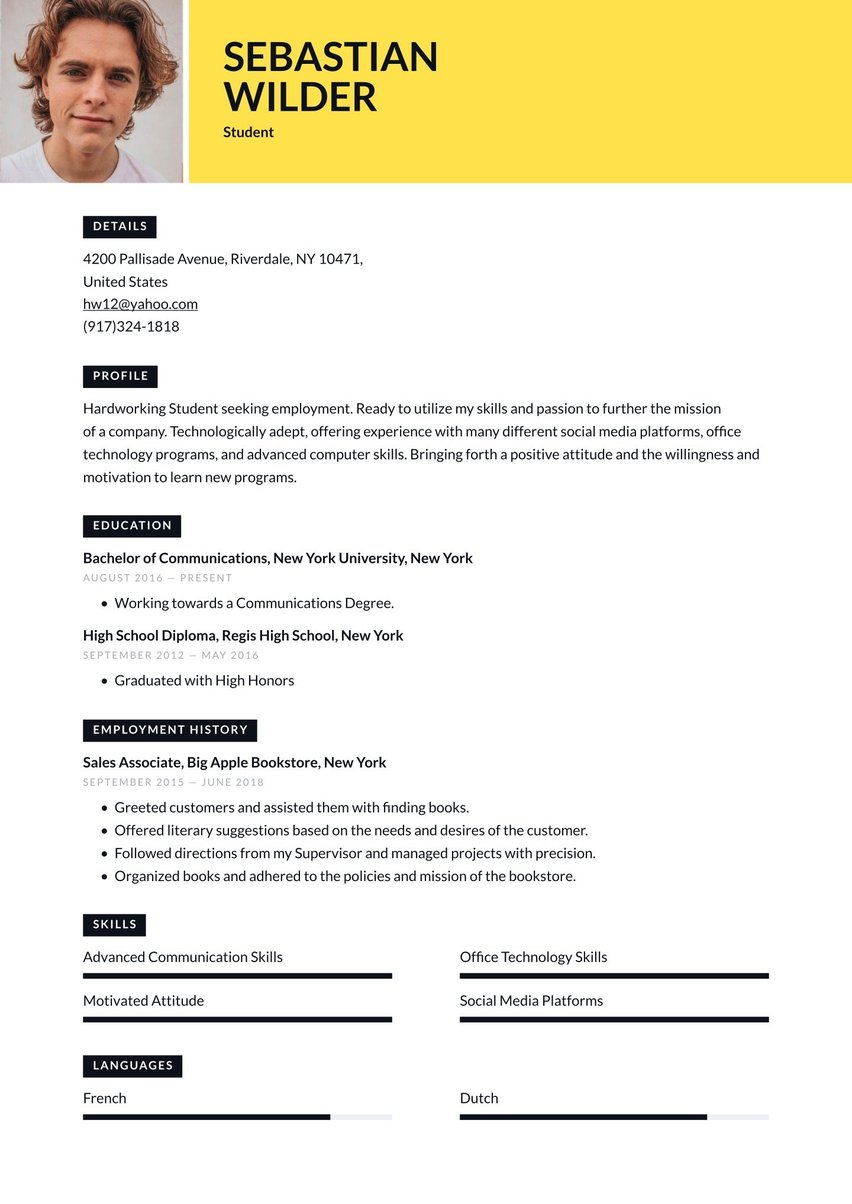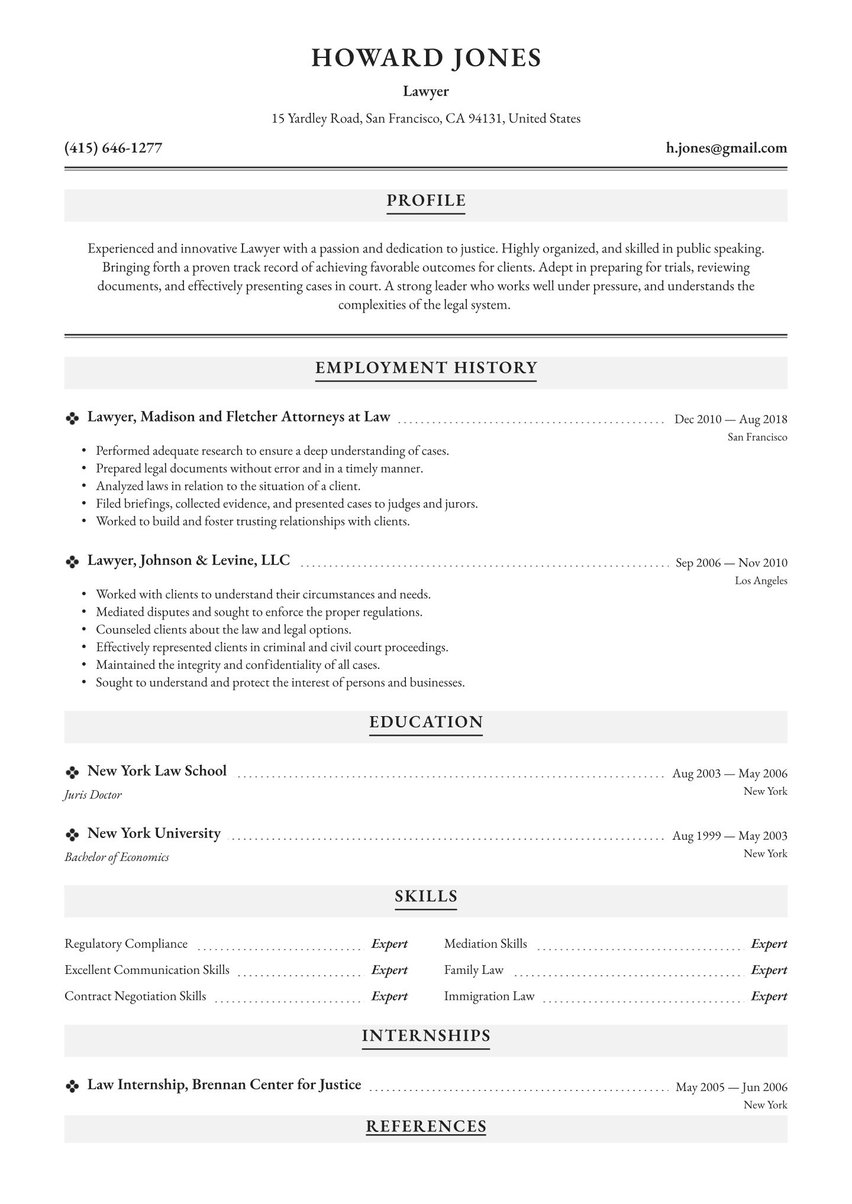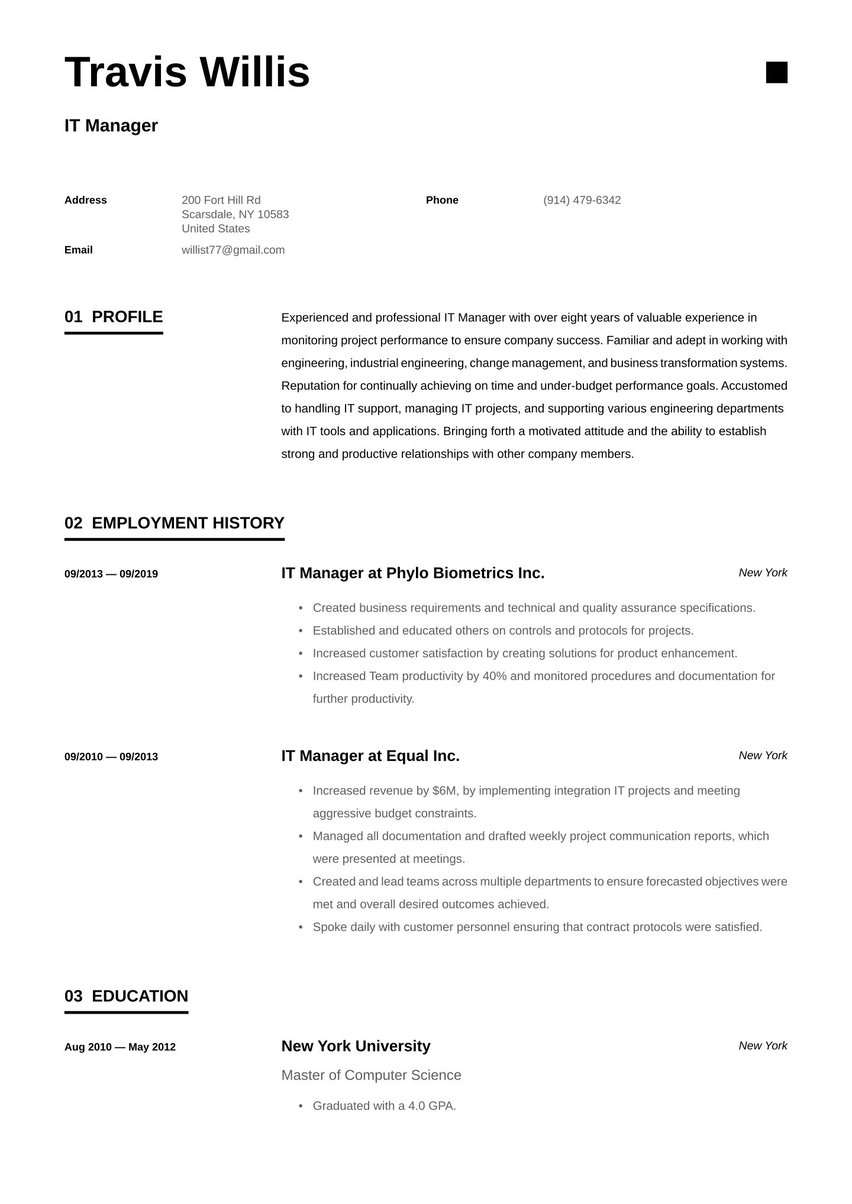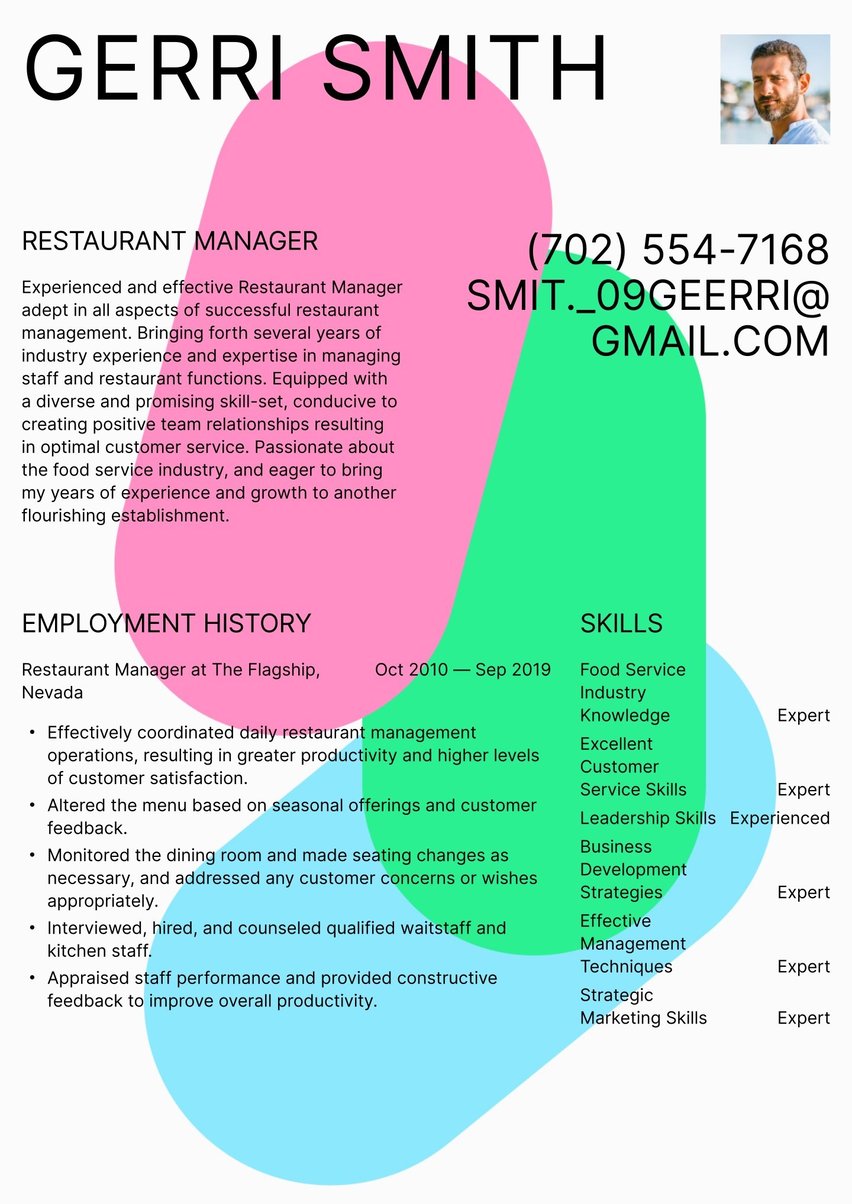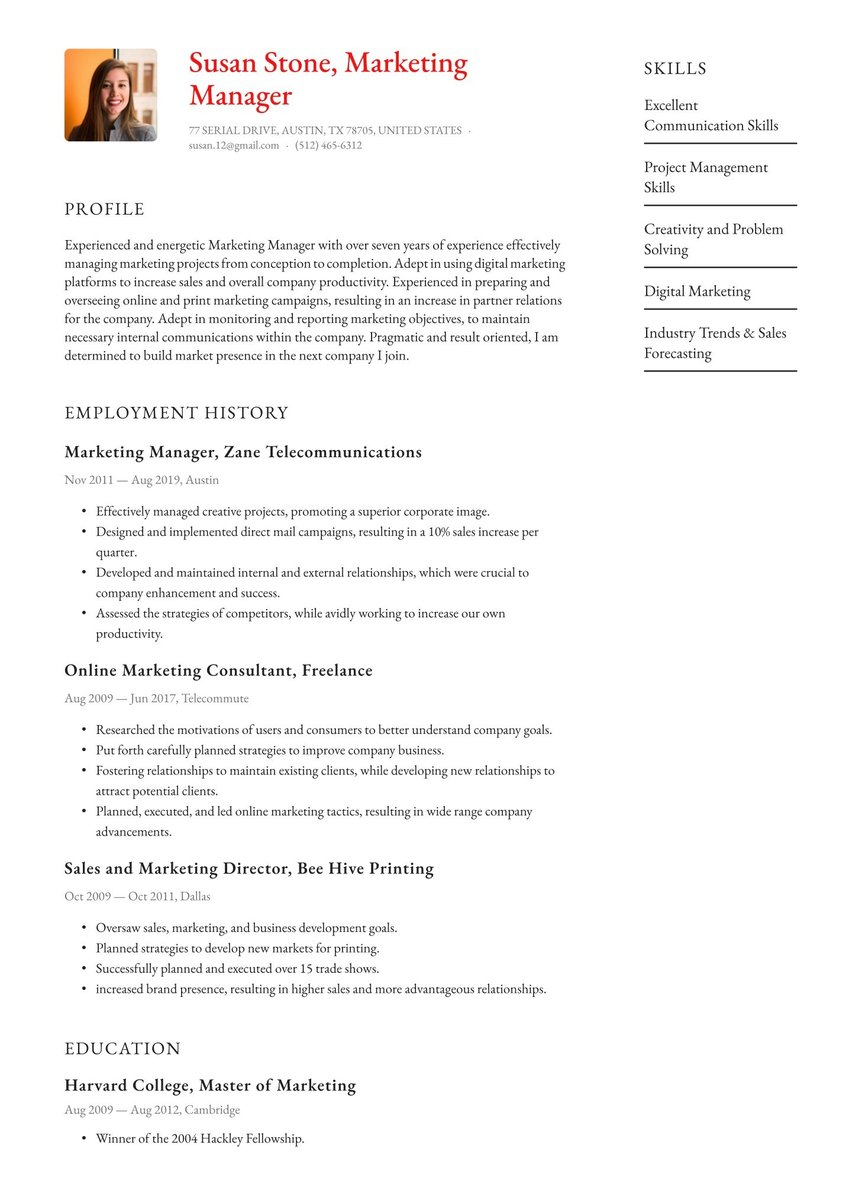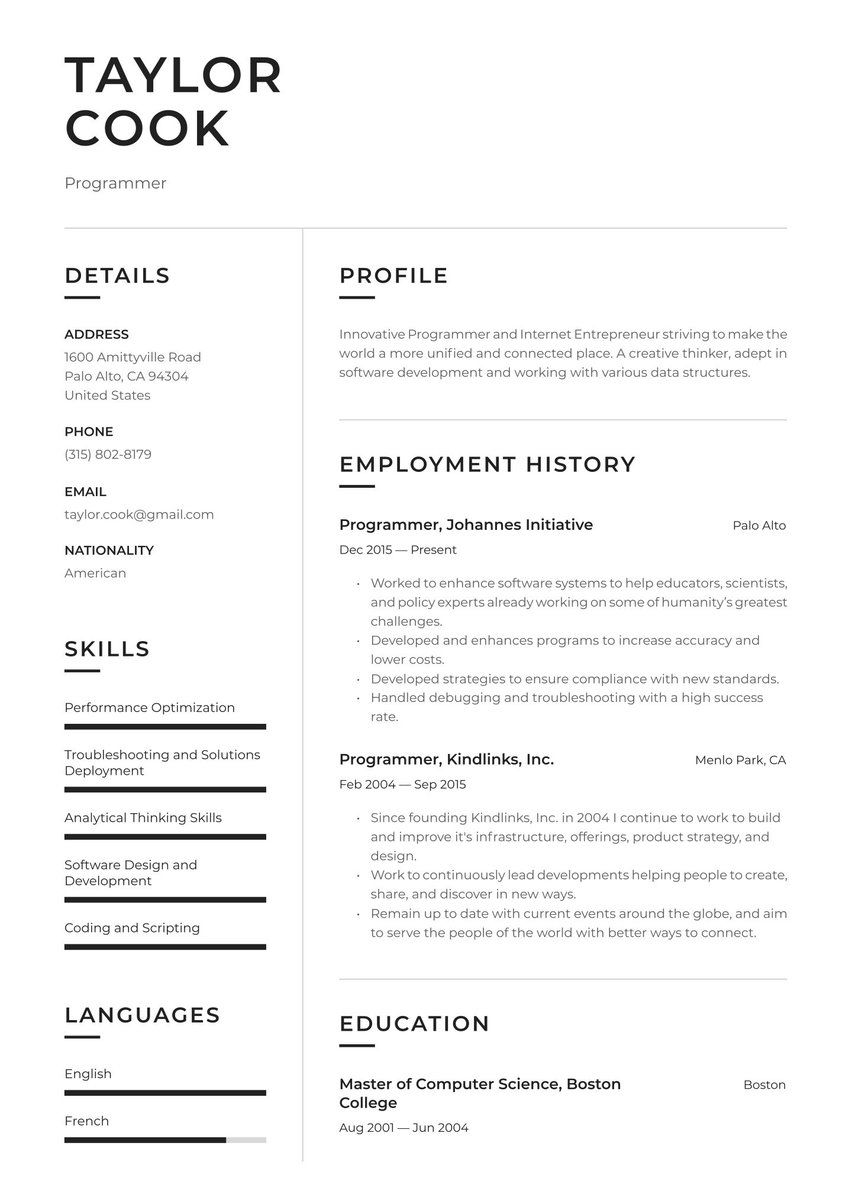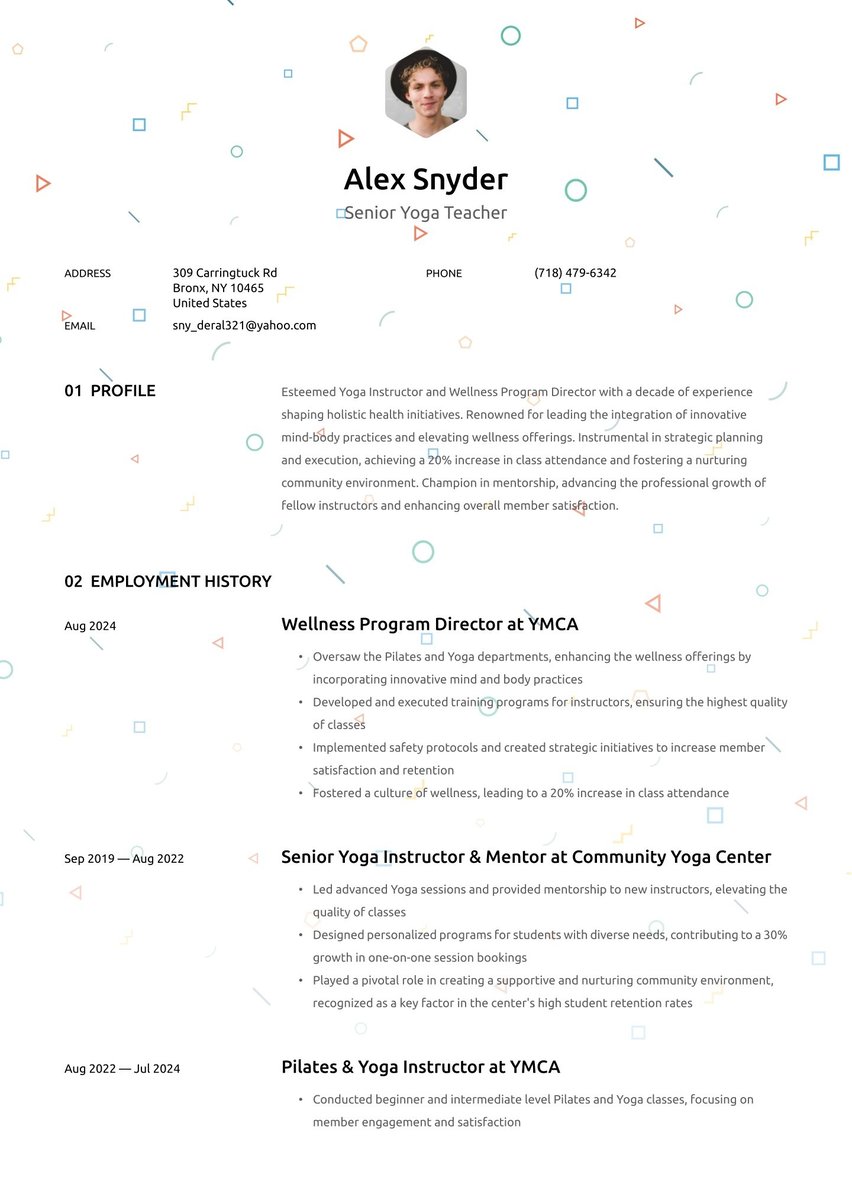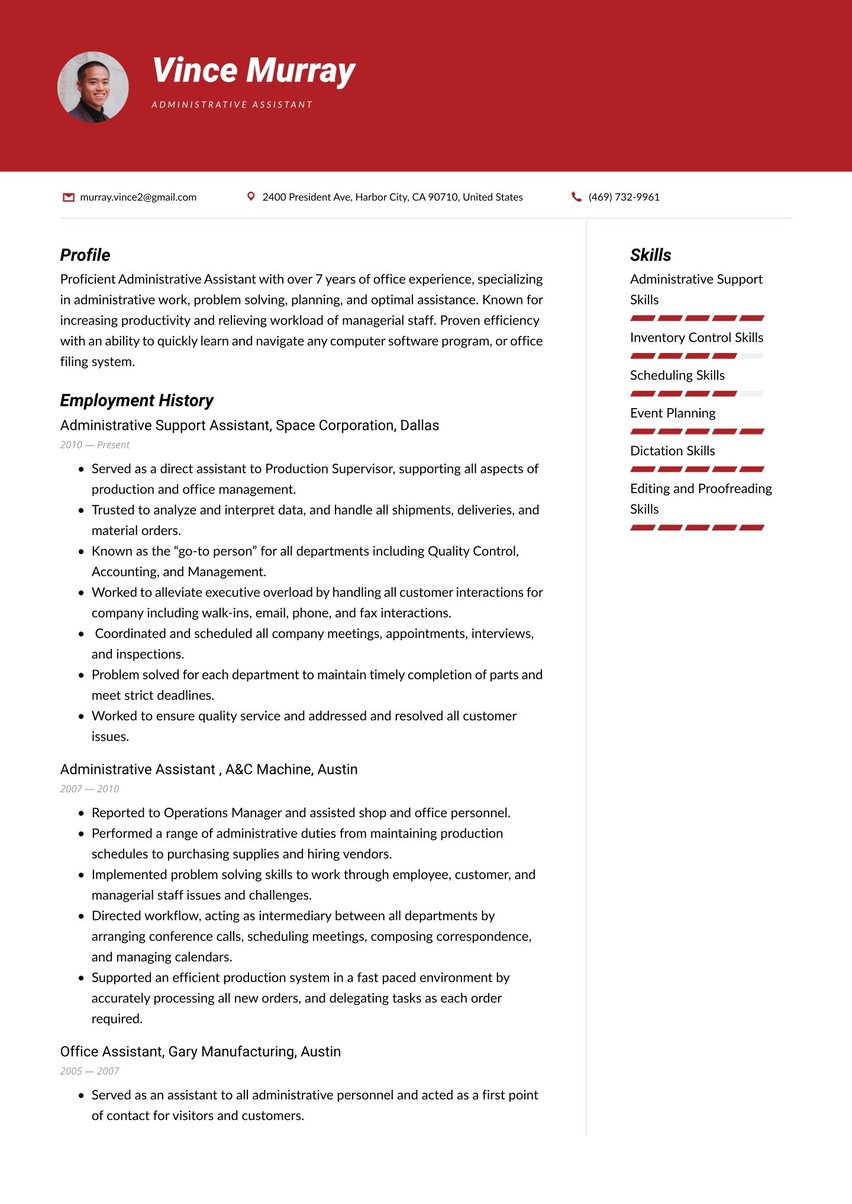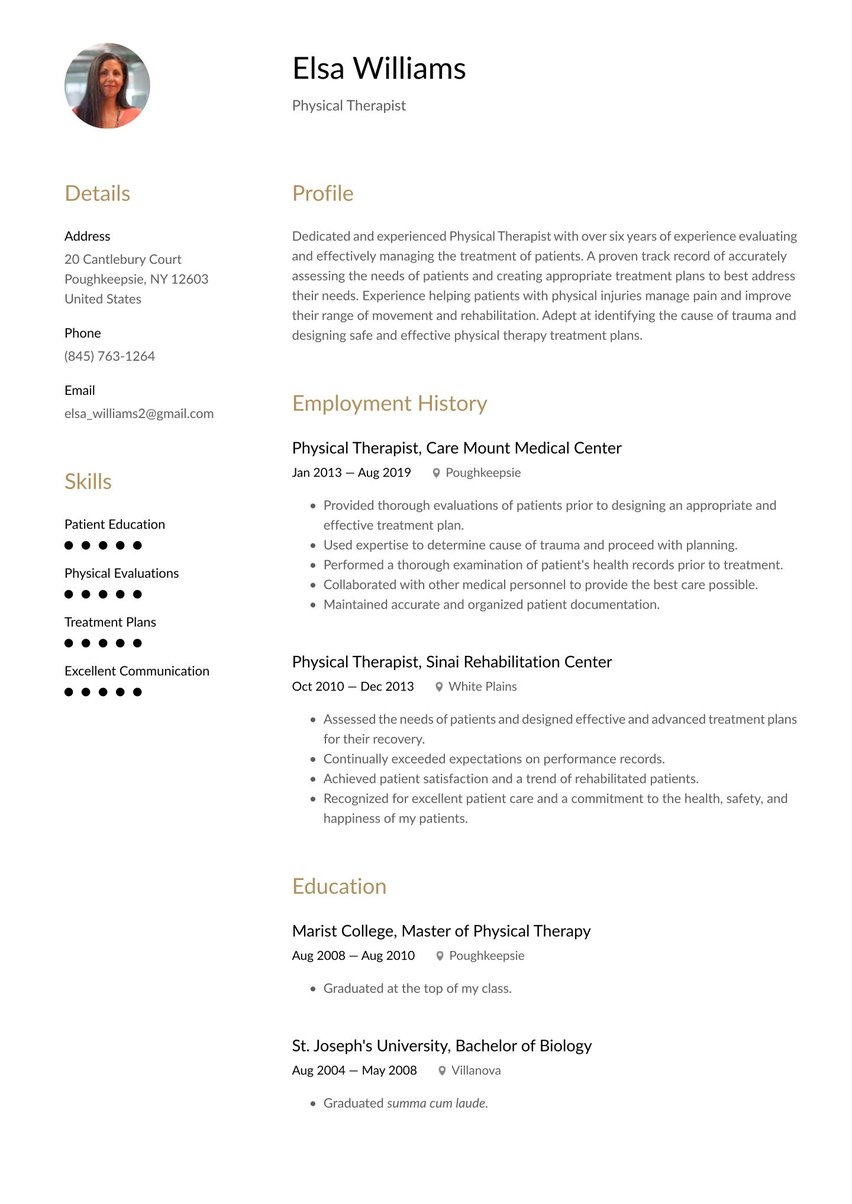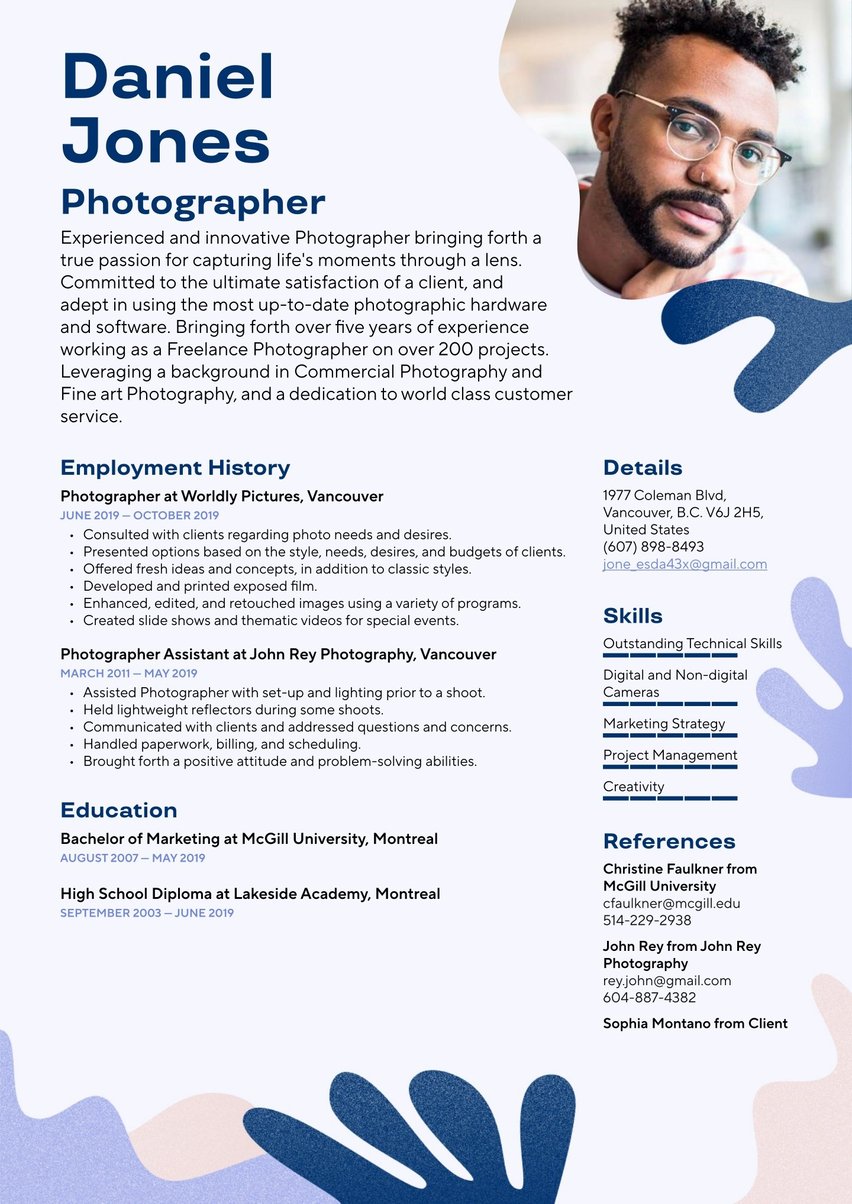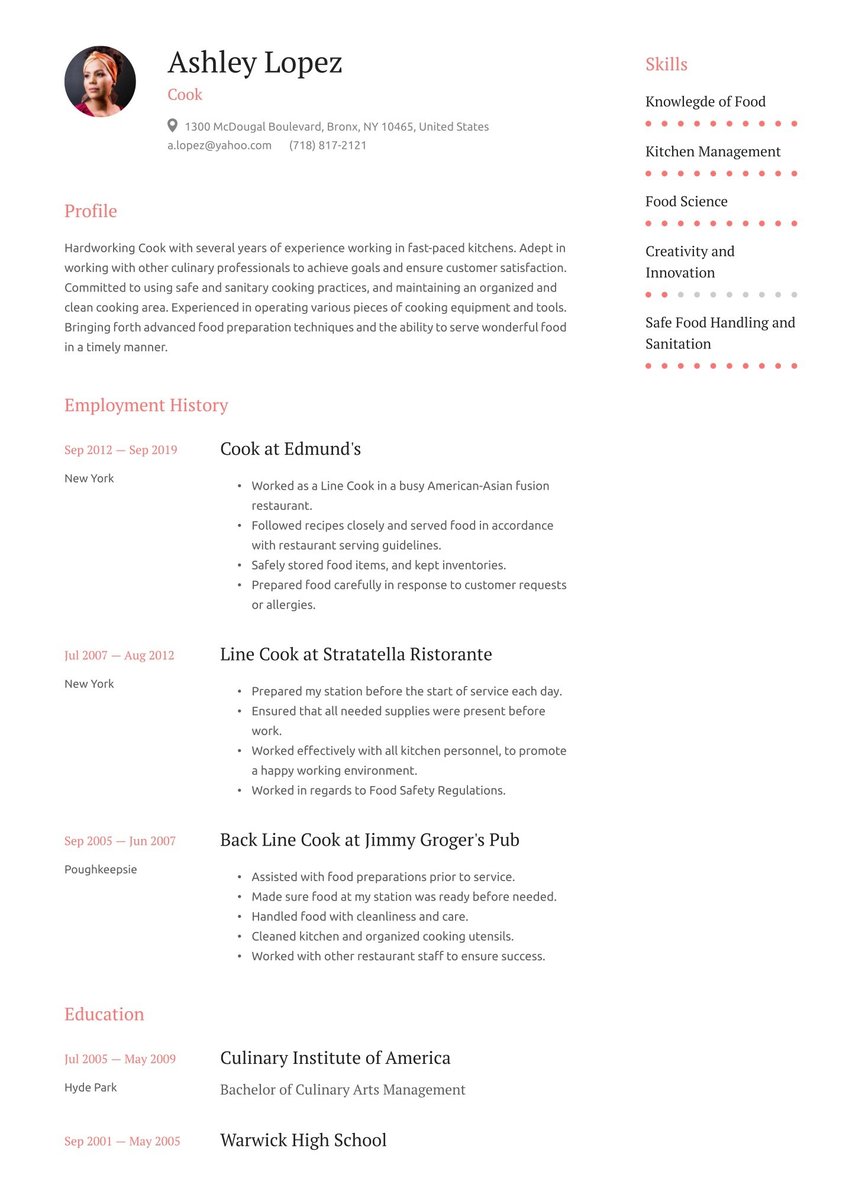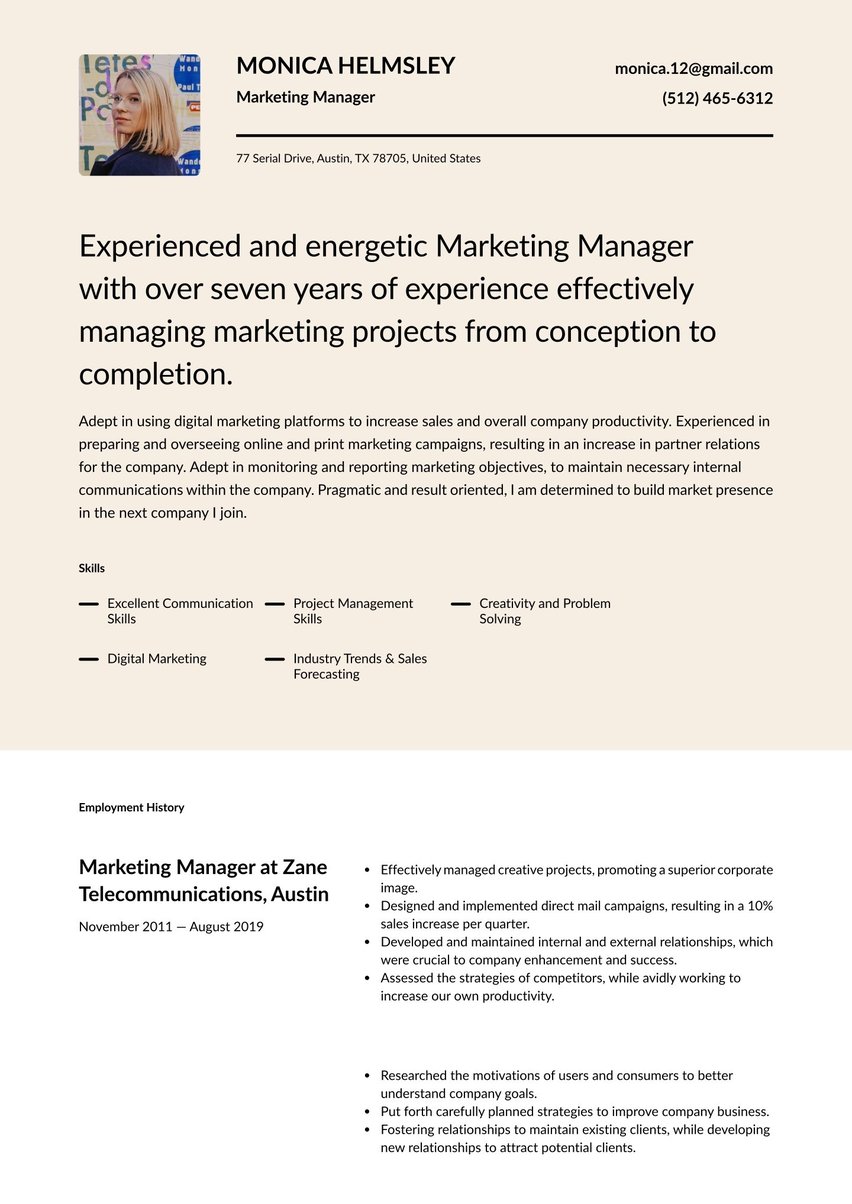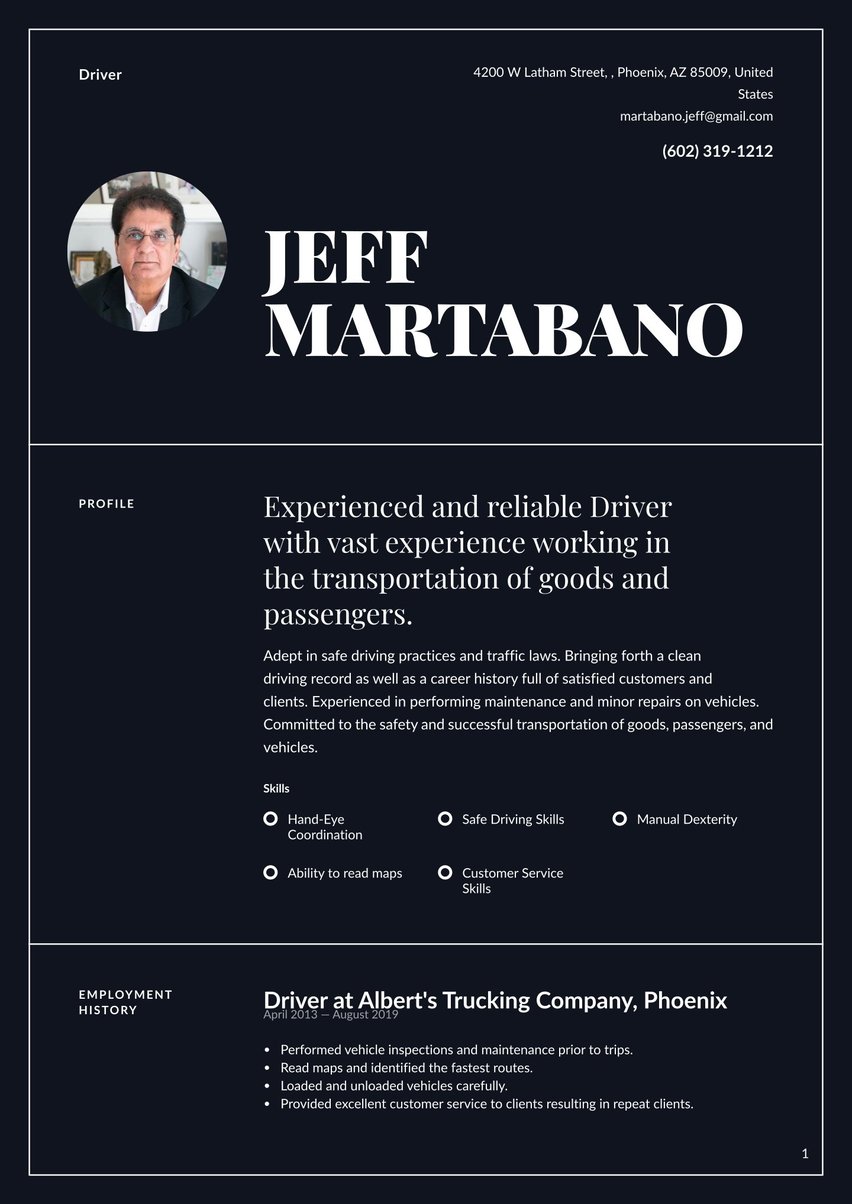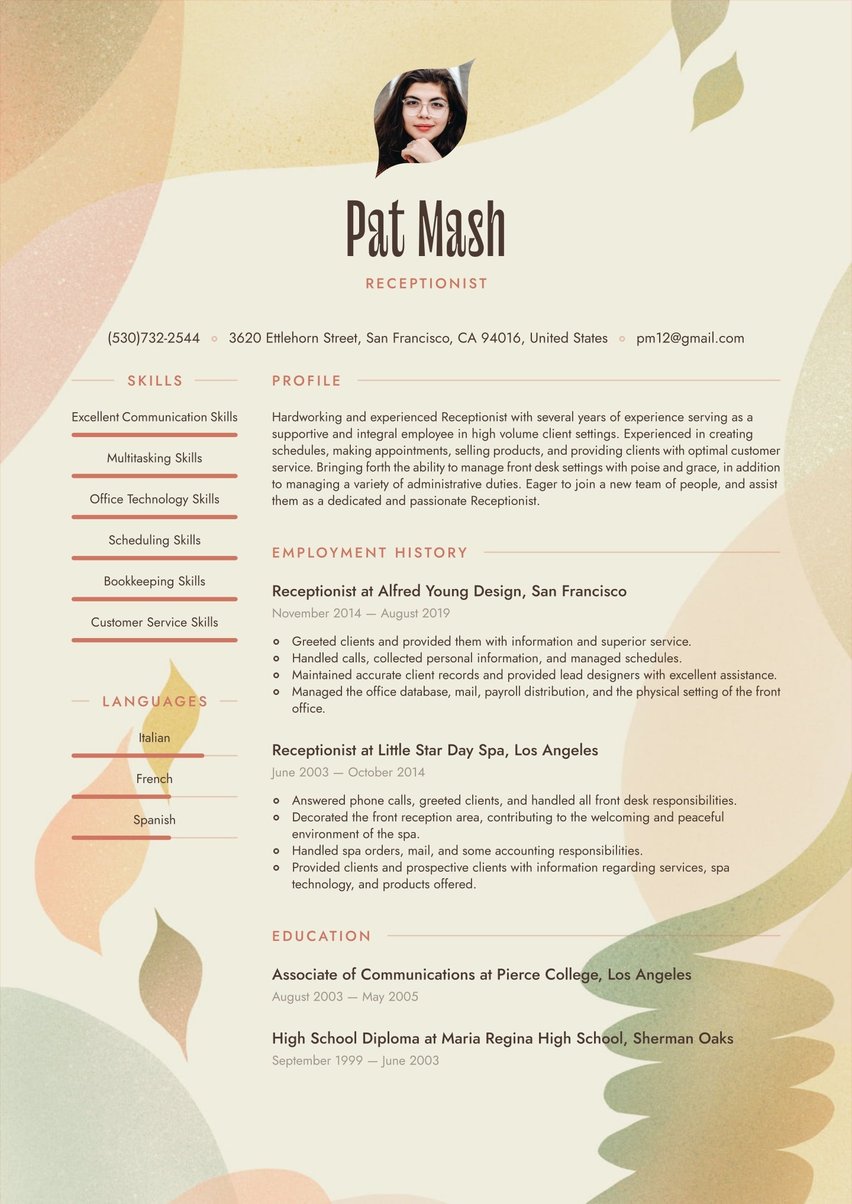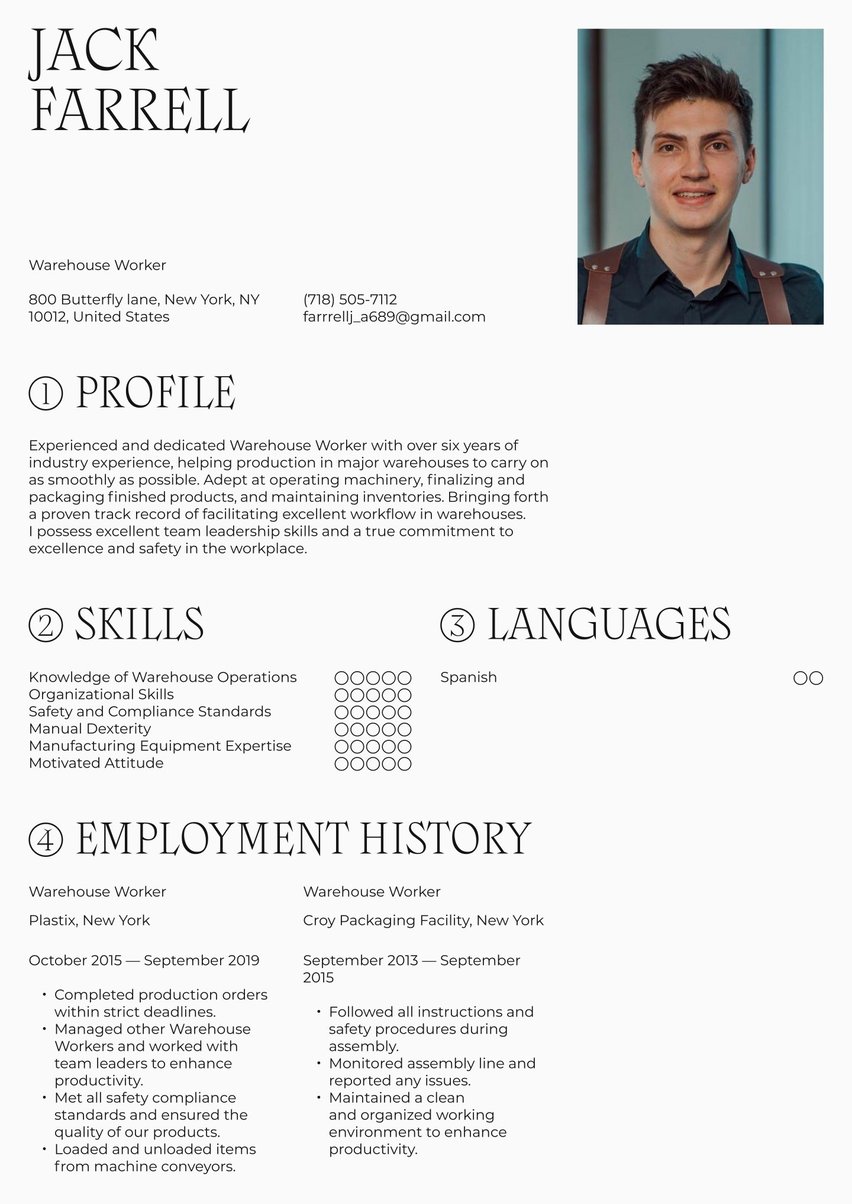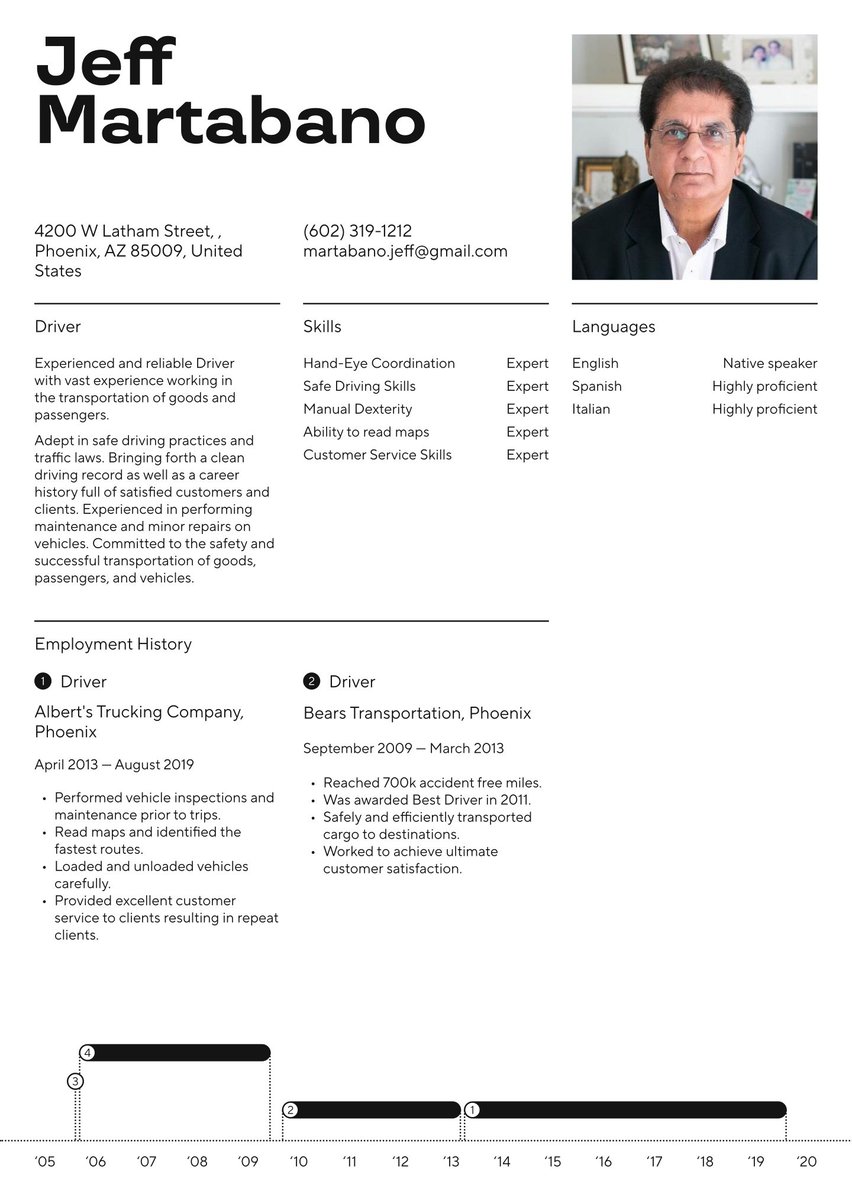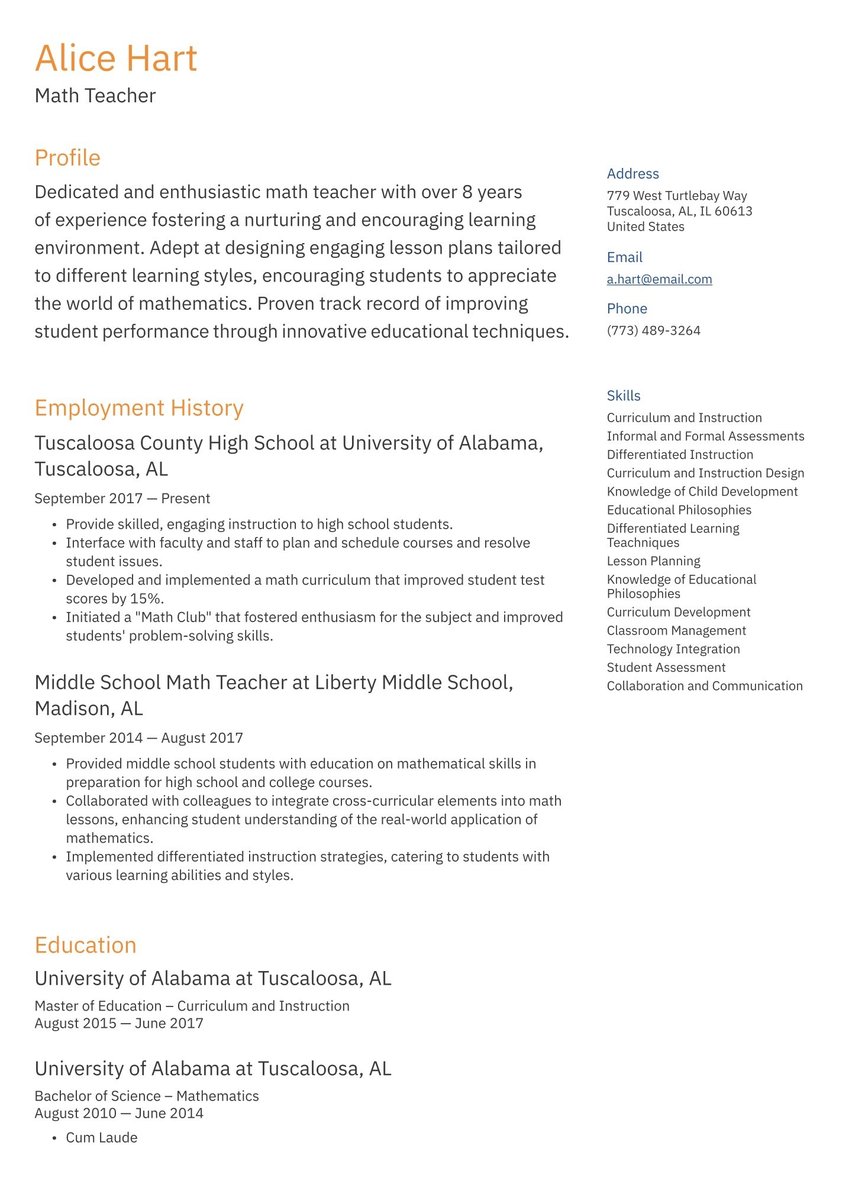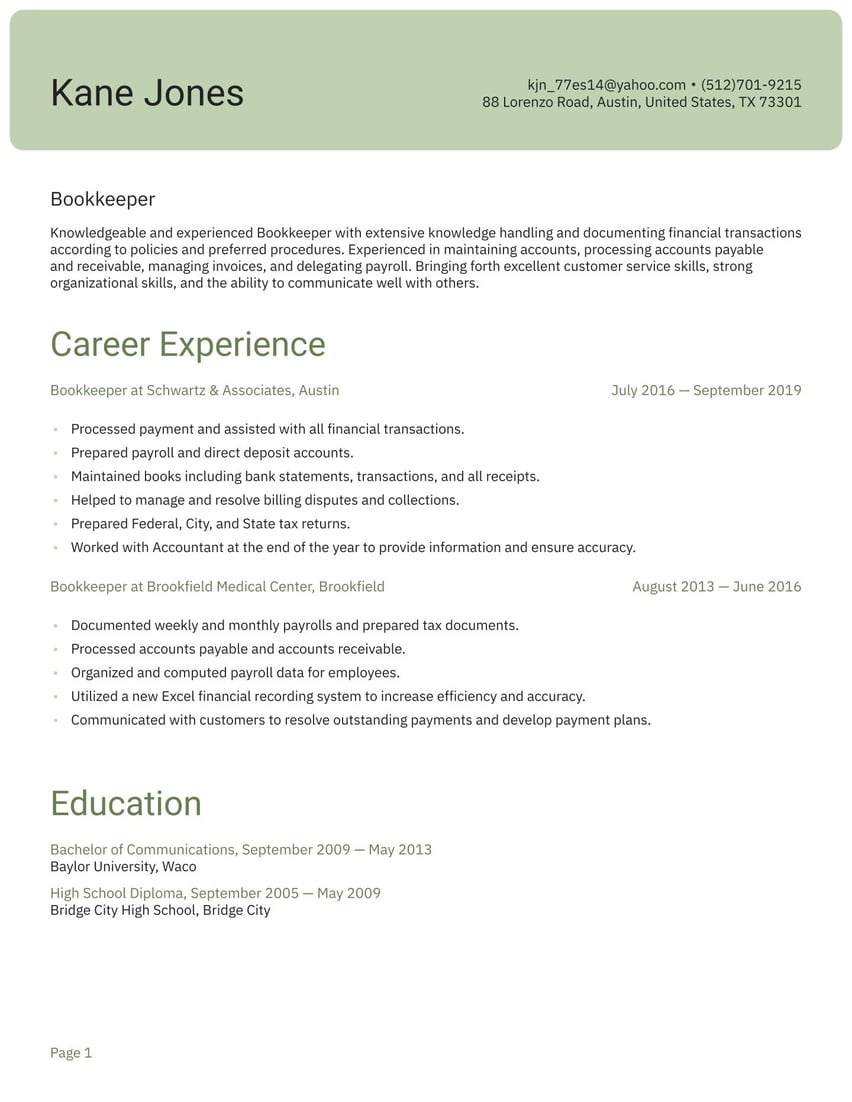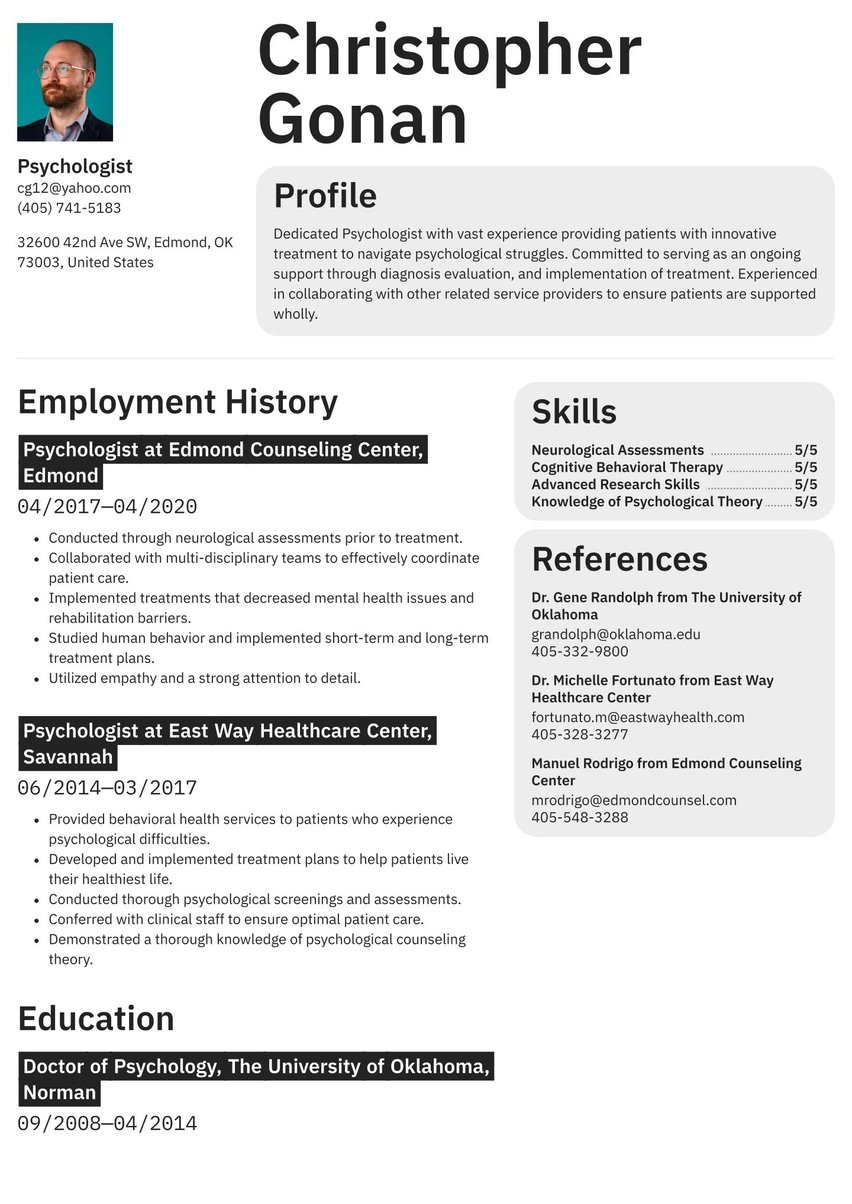As a student athlete, you know how to get warmed up for a big game, but when it comes to writing your resume, you may feel unprepared to win. However, just like you wouldn’t show up to a game without spending hours at practice, you can’t just throw together a resume in a few minutes.
Student Athlete resume examples by experience level
Instead, you need to leverage strategy, practice, and a winning mindset to get your head in the game. This will get you set up for success, helping you land your dream job — whatever career path you’ve set your sights on.
Resume guide for a student athlete resume
Score your next job with help from Resume.io. With our guides and resume examples (which cover over 500 professions!), and our resume builder, it’s easier than ever to draft a winning resume.
If you’re wondering how to put student athlete experience on your resume, we’ve got you covered. The following resume guide and student athlete resume example will walk you through the following:
- How to write a student athlete resume
- Choosing the right resume format to show off your student athlete experience
- How to display your contact information
- Using a summary or profile
- Adding your student athlete experience
- Listing your education
- Picking the right student athlete resume design/layout
- What the job market and salary possibilities look like for student athletes
How to write a student athlete resume
Your student athlete resume is like your playbook for success; if it’s well-written, easy to read, and showcases your unique talents, it’ll lead you to career victory.
The first step toward your goal is understanding the sections your resume must include:
- The resume header
- The resume summary (aka profile or personal statement)
- The employment history section
- The resume skills section
- The education section
The best way to pull these components together to craft the overarching narrative of your athletic and educational career is by following this formula:
- Focus on accomplishments, not responsibilities. Anyone can simply list the work they were assigned, but you’ll have a better shot if you display the value you brought to the team.
- Tailor your resume to each employer; adjust your tone and style to the employer’s, making it easy for them to imagine you fitting into the role immediately.
- Use a resume template that’s professional and nice to look at.
- Include relevant keywords based on the job description. This way, whether your resume is reviewed by a human recruiter or an advanced algorithm, it will hit on all the right points.
Optimize for the ATS
An applicant tracking system, or ATS, is software used by companies to collect and track applications. Advanced systems may offer features that include an algorithm to help sift through resumes. For example, it may assess whether resumes match up with the key requirements in the job posting, then rank them based on the strongest matches.
To win with the ATS, be sure to do your own scanning — of the job posting — and determine the highest-priority skills and traits. Make sure your resume reflects them.
Choosing the right resume format for a student athlete
The format of your resume should be like your team uniform: sleek, professional, and eye-catching but not distracting.
This means that, as for the majority of resumes, you should start with a reverse chronological format. When drafting your resume, you’ll put the most focus on your student athlete (and other) experience, listing it in reverse chronological order so the most recent experience is front and center.
For those with limited experience or trying to make a career change, a functional resume format may be useful. This puts the focus on your skills and attributes rather than specific job history. Or, try a hybrid format that mixes them both.
Whichever you choose, you can see them in action among the numerous resume templates in our resume builder. There are examples of each format available as resume samples.
To ensure your resume is sleek and eye-catching like the best team uniforms, we recommend a modern layout. This offers the best of both worlds: simple and professional enough to put the focus on your work, but well-designed enough to draw in the reader.
Include your contact information
Every resume should make it clear from the start who it belongs to, just like you write your name on every paper or homework assignment you turn in as a student athlete — that’s why your header is an imperative part of your resume.
Be sure it’s clear, accurate, and well-presented. Include the following:
- Full name & title. List your first and last name and the title of the role to which you’re applying.
- Professional email address. If you haven’t already, sign up for a professional email address with a format like [email protected]. Avoid quirky, silly, or unprofessional email addresses.
- Phone number. Include a number where you can easily be reached, and make sure your voicemail greeting is professional. Avoid letting your voicemail box fill up — you want companies to be able to leave you a message!
- Location. Just list your city and state, not your zip code and especially not your street address. That’s outdated, but also puts your safety at risk. If you’re trying to relocate, or even just open to it, you can note “willing to relocate” here.
- LinkedIn. If you have an active LinkedIn profile that shows you as a high performer in your industry, include it here.
Don’t include:
- Date of birth: This isn’t necessary and isn’t customary in the US. Plus, it could lead to age discrimination.
- Personal details: Much like your birth date, things like your marital status, social security number, etc. are not customary to include in the US.
- Photo: While this is expected in some countries, it’s not typical in the US to include your photo on your resume.
Make use of a summary
Just like in your sport(s) of choice, your resume should highlight your MVP moments. The best way to do this is by using your summary to show off the achievements that set you apart from the competition.
In 2-4 sentences, pull together your overarching achievements and winning moments, making it clear to the reader that you’re exactly the person they’re looking for. Don’t just list job duties or reiterate what’s elsewhere on your resume. Instead, use action verbs and quantifiable or specific accomplishments to demonstrate your unique value.
Just like baseball players come out to bat with a walk-up song, you can use your summary to get the reader excited about getting to know you and see you in action.
If you’re looking for inspiration, check out our related resumes:
Need inspiration for your summary? Check out our related resumes:
- Sports resume sample
- Rowing Coach resume sample
- Soccer Coach resume sample
- Swimming Coach resume sample
- Nutritionist resume sample
- Recreational Facility Attendant resume sample
- Track Coach resume sample
- Tennis Coach resume sample
- Lifeguard resume sample
- Hockey Coach resume sample
- Golf Instructor resume sample
- Football Coach resume sample
- Basketball Coach resume sample
- Baseball coach resume sample
- Athletic Trainer resume sample
- Volleyball Coach resume sample
- Fitness Instructor resume sample
- Personal Trainer resume sample
- Yoga instructor resume sample
You can find adaptable student athlete resume example summary below:
Motivated college student and high-achieving student athlete with a proven track record of teamwork, leadership, and exceeding goals. One year of team captain experience and two years of mentorship to new team members.
College graduate with four years as an accomplished student athlete. Strong foundation in leadership, team collaboration, and driving to success. Proven ability to exceed goals and meet challenges head-on; eager to leverage this experience in a sales position.
Sales representative with 2 years of experience exceeding quotas and increasing revenue. Accomplished student athlete career provides strong foundation for leadership, inspiring and coaching teams, and resilience.
Outline your student athlete work experience
Your work experience is what will lead you to victory, so it needs to show your strategy, determination, and drive to succeed.
Start by listing each position (in reverse chronological order if you’ve chosen that format), and under each employer and job title, detail your achievements in bullet point statements. Start each bullet point with a meaningful verb (think: achieved, won, negotiated, developed, exceeded, led).
As noted previously, this should not be a list of your job duties, but instead a display of your accomplishments. For instance, a resume that lists your tasks may look something like this:
- “Played football for the college.”
- “Attended classes.”
- “Trained and mentored new teammates.”
While that gives a general idea of what you did, it doesn’t do anything to set you apart or show why you’re the ideal candidate. To make your resume more impactful, replace those vague statements with ones that emphasize results. What was the specific impact you made on the team? What did you accomplish that others did not? What sets you apart?
Reworking those phrases transforms them into something much more interesting:
- “Trained and practiced 20 hours per week alongside full academic course load, contributing to an undefeated season.”
- “Earned 3.75 grade point average and Dean’s List designation.”
- “Served as team captain, inspiring and leading the team while mentoring new teammates.”
Take a look at the sample student athlete resume summary section below:
Marketing Intern at Carolina Panthers, Charlotte, NC
June 2020 - August 2020
- Assisted in developing and executing marketing campaigns for team's social media platforms.
- Conducted market research to identify trends and opportunities for fan engagement.
- Collaborated with cross-functional teams to create promotional content and analyze campaign performance.
Varsity Women's Soccer Team at University of North Carolina, Chapel Hill, NC
August 2018 - Present
- Served as starting midfielder and team captain (2020-2021 season).
- Member of ACC All-Academic Team (2019, 2020).
- Ranked as ACC Champions (2019).
- Participated in NCAA Division I Women's Soccer Tournament (2018, 2019).
How to write a student athlete resume with no experience
If you’re applying to a job outside of the realm of athletics but you lack direct experience, you can still create a resume that scores the goal.
You just need to focus more on your transferable skills from student athletics rather than trying to come up with skills that are exactly related to the job. Depending on the job you’re applying to, these transferable skills may include leadership, problem-solving, strategy and planning, coaching, time management, or team collaboration.
Include your educational background and call out any relevant courses you’ve taken. If you’ve gone through any related certifications or even trainings or webinars, add it in.
Include the relevant key skills that make you a great student athlete
Your resume’s skills section is like your stat sheet — it shows the abilities and talents that make you a top draft pick for the employer.
The skills in this section can be a mix of hard and soft skills. Hard skills are those that can be demonstrated or measured, like knowledge of the rules of a sport.
Soft skills are those that pertain more to intrinsic personality traits and how you engage with others. For example, soft skills may include communication skills, teamwork, or time management.
If you need help thinking of your top skills, Resume.io offers a resume builder with several key skills to choose from. You also have the option to include your own.
Here’s what the skills box looks like in our student athlete resume template.
- Social Media Marketing
- Market Research
- Data Analysis
- Adobe Creative Suite (Photoshop, Illustrator)
- Strong Communication and Interpersonal Skills
- Time Management and Organization
- Leadership and Teamwork
Of course, your skills section isn’t the only place to include your skills. Show them in action throughout your resume by sharing specific examples and achievements in your experience and summary sections.
For example, you could highlight:
- Leadership skills by sharing how you inspired and led your team to success, or designations you’ve earned as team captain or similar roles.
- Drive and tenacity by noting how you contributed to a major team turnaround from an underdog to winners, or how you helped solve a tough team problem.
- Time management by showing how you remained part of a high-performing athletic team while still achieving high grades and a full course load.
Whatever role you’re applying for, the job description is a great guide as to which skills are best to include.
Detail your education & relevant student athlete certifications
As a student athlete, the education section is fairly straightforward. Whether you’re still in school or have graduated, include your educational experience in this section in reverse chronological order.
However, that’s not all to include — if you have any other certifications, training, or development, you can show them off here. Think about things like:
- Training and certifications. Have you taken courses related to the job you’re targeting? Did your athletic experience include any leadership or collaboration training?
- Internships. If you found time alongside your athletic career to fit in an internship, adding it to your resume has multiple benefits. It shows your ability to manage your time and succeed through challenges, and it can also show relevant experience if the internship is related to the job you’re seeking.
- Clubs or societies. If you were part of any clubs or groups, especially if they’re relevant to your target job, add them here.
Bachelor of Science in Business Administration (Marketing Concentration), University of North Carolina, Chapel Hill, NC
August 2018 - May 2022
Pick the right resume layout and design for a student athlete resume
The design and layout of your resume should be like the top sports equipment: functional yet attractive, easy to understand, and serving its purpose.
To achieve this, you should avoid going overboard with color, graphics, or fonts. While a pop of color is fine, only use it sparingly and don’t use more than one. Don’t use tables or too many columns, as that can be challenging for humans to read and difficult for systems to parse.
Remember, too, that at this stage in your career, a single-page resume is fine. It’s ideal if you can fill a whole page, but be sure to do so with relevant information — not by increasing your font size beyond size 12 or so.
Your best bet is to use a resume template with ample whitespace, a professional font, and no graphics. If you don’t feel design is your forte, rely on our many resume templates. We take care of the structure, formatting, and design for you so your experience speaks for itself.
Student athlete text-only resume example
Profile
Enthusiastic student athlete with sports marketing knowledge backed by excellent academic training, strong work ethic, leadership abilities, and passion for sports. Collaborative team player, adept at communicating with cross-functional colleagues to complete projects on time and budget. Thrive in fast-paced, demanding environments requiring sharp attention to detail.
Employment history
Marketing Intern at Carolina Panthers, Charlotte, NC
June 2020 - August 2020
- Assisted in developing and executing marketing campaigns for team's social media platforms.
- Conducted market research to identify trends and opportunities for fan engagement.
- Collaborated with cross-functional teams to create promotional content and analyze campaign performance.
Varsity Women's Soccer Team at University of North Carolina, Chapel Hill, NC
August 2018 - Present
- Served as starting midfielder and team captain (2020-2021 season).
- Member of ACC All-Academic Team (2019, 2020).
- Ranked as ACC Champions (2019).
- Participated in NCAA Division I Women's Soccer Tournament (2018, 2019).
Skills
- Social Media Marketing
- Market Research
- Data Analysis
- Adobe Creative Suite (Photoshop, Illustrator)
- Strong Communication and Interpersonal Skills
- Time Management and Organization
- Leadership and Teamwork
Education
Bachelor of Science in Business Administration (Marketing Concentration), University of North Carolina, Chapel Hill, NC
August 2018 - May 2022
Student athlete job market and outlook
Student athletes move into many types of careers, so there’s no single statistic about the job market and outlook. That said, if you’re interested in parlaying your student athletics experience into a sports career, the outlook is bright. Thanks to ever-increasing public interest in sports, demand is increasing across the board.
- The US Bureau of Labor Statistics (BLS) expects a 9% increase in employment for athletes and sports players over the next decade. The average occupation should see only a 3% increase.
- Coach and scout employment is expected to increase 9% as well, while the BLS estimates a 10% increase for umpires, referees, and other officials.
What type of salary student athletes can expect
As noted, there’s no single career of choice for student athletes, so there’s no single salary to shoot for.
When looking at those who remain in the sports industry, the median salary for athletes is approximately $94,000, while coaches and scouts earn a median salary of $44,890. Referees, umpires, and other officials earn a median salary of about $36,000.
Key takeaways for building a student athlete resume
Your background as a student athlete has given you skills in more than just your sport of choice. You’re an expert in teamwork, leadership, problem solving, goal setting, and much more. Career opportunities are endless, but regardless which direction you go, you’ll need a winning resume.
By focusing on your skills, experience, and education, you’ll pull together an excellent career playbook that will make any hiring manager excited to each out.
Even better, our online resume builder helps you achieve your goals quicker by assisting with the design, format, and creation of your resume.
